eCommerce Replatforming: How It Helps You Stay Competitive
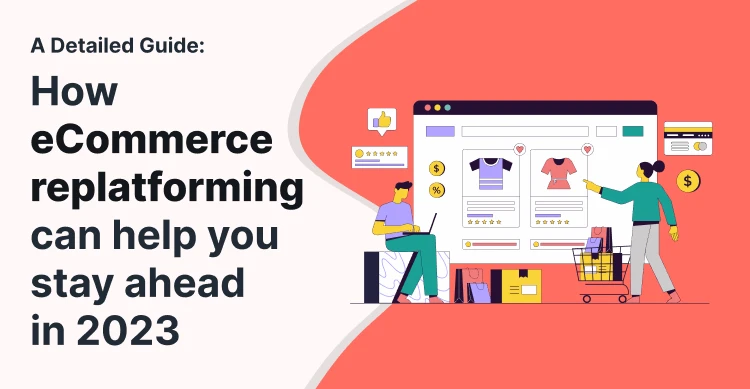
As we step into 2023, eCommerce continues to be a critical aspect of business growth and survival. However, the eCommerce world constantly evolves, with new platforms, features, and customer expectations emerging daily. That’s where eCommerce re-platforming comes into play.
In the rapidly changing face of e-commerce, staying competitive means keeping up with the latest technology trends. One crucial trend is eCommerce platform migration, also known as replatforming.
Replatforming refers to the process of moving an online store from one eCommerce platform to another, usually to modernize the store and take advantage of new features and capabilities.
Replatforming is not a trivial process, and there are many things to consider before embarking on such a project. For example, you need to understand the replatforming definition and understand what it means for your business. You also need to create an eCommerce replatforming checklist to ensure you don’t forget any important steps during the migration process.
In this detailed guide, we will explore the importance of eCommerce re-platforming in 2023 and how it can help you stay ahead in the highly competitive eCommerce landscape.
So, let’s dive in!
Strategies for Successful eCommerce Replatforming in 2023
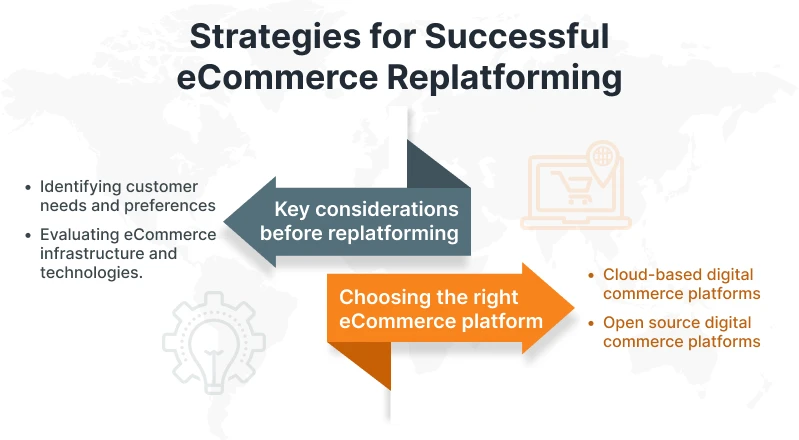
Replatforming eCommerce can be a challenging and complex process, and careful planning and consideration are necessary to ensure success. An excellent replatforming example is the migration of Etsy from its original platform to Google Cloud. This move allowed Etsy to scale more effectively, reduce infrastructure costs, and improve site performance.
When considering replatforming, there are different approaches you can take, such as application replatforming, cloud migration, and replatforming AWS, depending on your business needs. Additionally, you need to understand the platform migration steps to ensure a smooth transition.
We’ll explore some eCommerce business strategies for successful re-platforming in 2023.
Key Considerations Before Replatforming
Before re-platforming, it’s essential to identify the business’s needs and goals. It includes understanding customer needs and preferences, such as their preferred payment methods, shipping options, and product information.
It’s also important to assess the existing eCommerce infrastructure and technologies to determine which solutions are working well and which may need to be updated or replaced. By carefully considering these factors, businesses can ensure that they choose the right platform for their needs and goals.
Choosing the Right eCommerce Platform
When choosing the right eCommerce platform, businesses have two main options: cloud-based digital commerce platforms and open-source digital commerce solution platforms. Cloud-based platforms offer a range of built-in features, integrations, scalability, and flexibility. These platforms are better options for businesses that don’t have a dedicated IT team, as they generally offer robust security and support.
Open-source platforms offer even greater flexibility and customization options. They need more technical expertise and support and may require more time and resources to set up and maintain. Nevertheless, these platforms are good for businesses with unique needs or requirements.
There may also be instances where businesses might consider migrating from one platform to another, such as moving from Magento to Shopify or vice versa. This could be due to changes in business strategies, scale, or even customer requirements. Magento to Shopify migration allows businesses to benefit from the ease of use, customer support, and security that Shopify provides. On the other hand, moving from Shopify to Magento might appeal to businesses seeking higher levels of customization and control, albeit with a greater need for technical expertise.
By carefully considering key factors such as customer needs and preferences and existing infrastructure and technologies and choosing the right platform, businesses can set themselves up for success in the competitive world of eCommerce in 2023. According to Digital Commerce 360, 61% of ecommerce companies plan to migrate in 2023, with 27% already considering it.
Navigating the Challenges and Opportunities of Replatforming in 2023
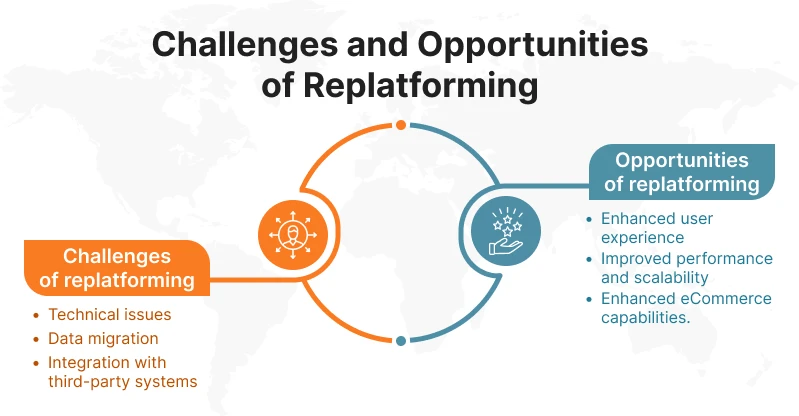
Common Challenges of Replatforming
Technical Issues: Replatforming requires extensive knowledge and expertise in technology and programming. Upgrading or replacing software platforms can require adapting to new programming languages, frameworks, and tools, which can be complex and time-consuming.
In addition, there can be compatibility issues between different software platforms that need to be resolved. Therefore, you must look for an ecommerce replatforming consultant and seek his guidance in order to execute the process smoothly.
Data Migration: Data migration is a critical aspect of replatforming, and it can result in data loss or corruption if not executed correctly. Maintaining data integrity during the transition is essential, and ensuring that the data is accurate, secure, and available.
Integration with Third-Party Systems: Integrating with third-party systems is essential for companies but can present unforeseen complications. Identifying all third-party systems and their dependencies is crucial, and creating a plan to ensure their seamless integration with the new platform.
Opportunities of Replatforming
Enhanced User Experience: A new platform can offer an improved user interface, personalized experiences, and seamless integration across devices, leading to an enhanced user experience.
Improved Performance and Scalability: Replatforming can improve performance and scalability, allowing companies to handle more traffic and transactions without experiencing downtime.
Access to Advanced Features and Functionality: A new platform can offer access to advanced features and functionality that were not available on the old platform, allowing companies to stay ahead of the competition.
It highlights the importance of careful planning for data migration and integration with third-party systems, enabling companies to successfully navigate the challenges and take advantage of the opportunities that re-platforming presents in 2023.
Maximizing ROI through eCommerce Replatforming in 2023: Key Considerations and Best Practices
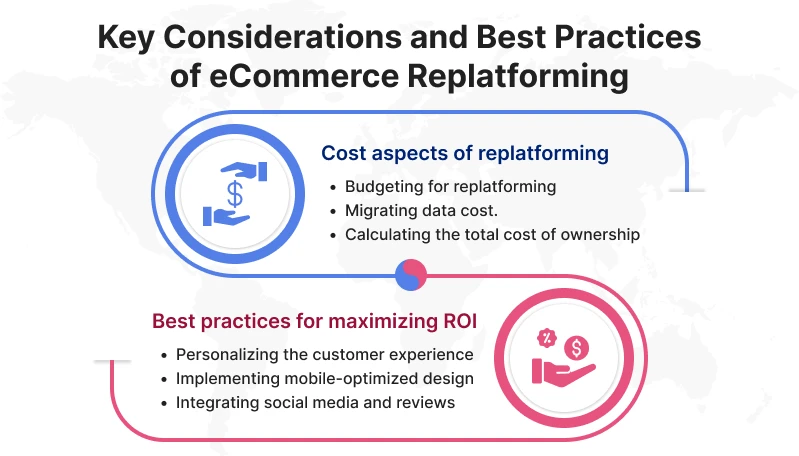
Replatforming can be a significant investment, and it’s crucial to consider the cost and ROI implications before making the switch. In this blog post, we’ll explore the key considerations and best practices for maximizing ROI through eCommerce replatforming in 2023.
Cost Considerations of Replatforming
Budgeting for re-platforming
Replatforming can be expensive, and you’ll need to allocate funds for various expenses, such as platform fees, design and development costs, and migration expenses. Digital Commerce 360 reveals that most ecommerce merchants plan to spend between $25,001 and $500,000 on switching platforms.
Therefore, it’s essential to thoroughly analyze your current eCommerce platform and identify the areas that need improvement. This analysis will help you develop a clear understanding of the costs involved in replatforming and ensure that you’re allocating your resources appropriately.
Calculating the Total Cost of Ownership
Another essential consideration when replatforming is the total cost of ownership (TCO). TCO is the sum of all costs associated with owning and operating a platform, including hardware and software, maintenance and support, and licensing fees.
Understanding the TCO of your current platform and the platforms you’re considering will help you decide which platform offers the best ROI.
Best Practices for Maximizing ROI
Personalizing the Customer Experience
Personalization is a critical element of eCommerce success in 2023. Consumers expect personalized experiences, and eCommerce businesses that deliver them see better conversion rates and higher customer loyalty.
Therefore, when replatforming, it’s essential to consider how you can personalize the customer experience on your new platform. This could involve implementing personalized product recommendations, targeted marketing campaigns, or customized landing pages. By providing a personalized experience, you’ll improve customer satisfaction and increase revenue.
Implementing Mobile-Optimized Design
When replatforming, it’s crucial to consider mobile optimization as a key factor in platform selection. Mobile optimization includes features such as responsive design, mobile-friendly navigation, and fast loading times. Optimizing for mobile devices will improve the customer experience, increase engagement, and drive revenue growth.
Integrating Social Media and Customer Reviews
Social media and customer reviews are powerful tools for eCommerce businesses in 2023. Integrating social media and customer reviews into your eCommerce platform will improve your brand’s social proof and increase customer engagement.
When replatforming, it’s essential to consider how you can integrate these tools into your new platform. This could involve implementing social sharing buttons, customer review widgets, or social media login options. By leveraging social media and customer reviews, you’ll improve your online reputation, drive customer loyalty, and increase revenue.
Replatforming can be a significant investment, but with careful consideration and planning, it can also be an excellent opportunity to maximize ROI.
By budgeting appropriately, calculating the TCO, and following best practices such as personalizing the customer experience, implementing mobile-optimized design, and integrating social media and customer reviews, you can ensure that your eCommerce replatforming is a success.
Streamlining Your Online Business: How eCommerce Replatforming Can Drive Growth in 2023
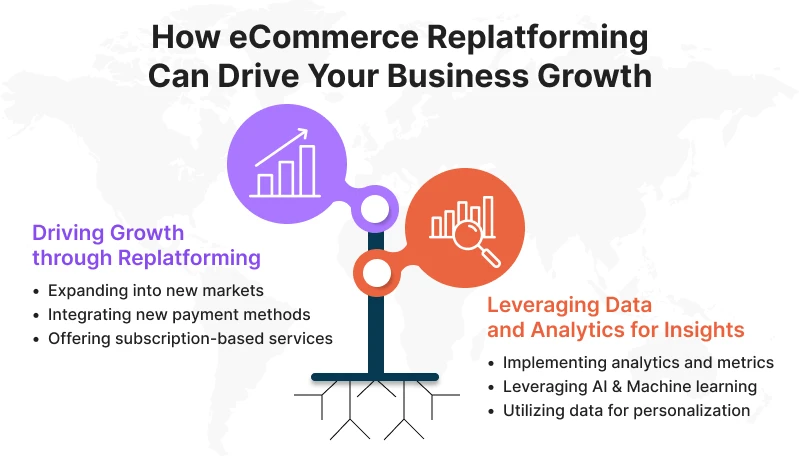
Replatforming can help businesses streamline their online operations and drive growth in 2023. This section will explore how eCommerce replatforming can drive growth and streamline your online business.
Driving Growth in eCommerce through Replatforming
Expanding into New Markets
Replatforming can help businesses expand into new markets by providing access to new features and integrations. When replatforming, it’s essential to consider the needs of your target market and select a platform that meets those needs. Expanding into new markets will increase your customer base and drive revenue growth.
Integrating New Payment Methods
Offering a variety of payment methods can help businesses reach more customers and increase conversions. When replatforming, it’s crucial to consider the payment methods your target market prefers and select a platform that supports those methods.
For example, if your target market prefers to pay using digital wallets such as PayPal or Apple Pay, you’ll need a platform that supports those payment methods.
Offering Subscription-Based Services
Subscription-based services are becoming increasingly popular in eCommerce and for good reason. By offering subscription-based services, businesses can create recurring revenue streams and build long-term customer relationships.
When replatforming, it’s essential to consider whether a subscription-based model is appropriate for your business and select a platform that supports this model. You’ll increase customer retention and drive revenue growth by offering subscription-based services.
Leveraging Data and Analytics for Business Insights
Implementing Analytics and Metrics
Data and analytics are critical components of eCommerce success in 2023. Businesses can gain insights into customer behavior, site performance, and sales trends by implementing analytics and metrics.
When replatforming, it’s essential to consider the analytics and metrics that will be available on the new platform and select a platform that provides the data you need to make informed business decisions. By leveraging analytics and metrics, you’ll identify areas for improvement and drive revenue growth.
Leveraging Machine Learning and AI
Machine learning and AI can help businesses automate processes, personalize the customer experience, and improve decision-making. When replatforming, it’s essential to consider the new platform’s machine learning and AI capabilities and select a platform that provides the tools you need to leverage these technologies.
By leveraging machine learning and AI, you’ll improve operational efficiency, increase customer satisfaction, and drive revenue growth.
Utilizing Customer Data for Personalization
Personalization is a critical component of eCommerce success in 2023. Businesses can personalize the customer experience and increase customer engagement by utilizing customer data.
When replatforming, it’s essential to consider the customer data that will be available on the new platform and select a platform that provides the tools you need to leverage this data. Utilizing customer data for personalization will improve customer satisfaction and increase customer loyalty.
eCommerce replatforming can help businesses streamline their online operations and drive the growth of the eCommerce industry in 2023. Businesses can increase revenue and reach new customers by expanding into new markets, integrating new payment methods, and offering subscription-based services.
The Top Trends and Technologies Shaping eCommerce Replatforming in 2023: Insights and Analysis
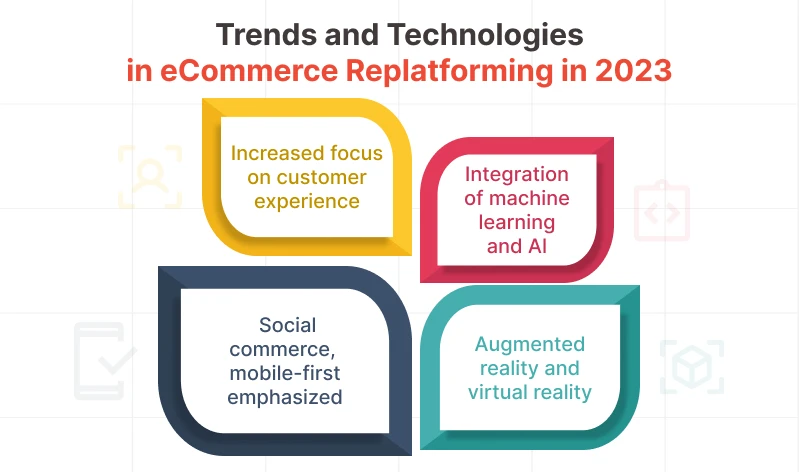
As eCommerce continues to evolve, businesses must adapt to stay ahead of the competition. One way to do this is by replatforming, which involves moving your eCommerce store to a new platform.
In this blog post, we’ll explore the top trends in eCommerce and technologies shaping eCommerce replatforming in 2023.
Increased Focus on Customer Experience
Customer experience has always been a critical component of eCommerce success, but in 2023, it will become even more important. With increased competition and rising customer expectations, businesses must prioritize delivering a seamless and personalized customer experience.
When replatforming, businesses must consider how the new platform can help them deliver a superior customer experience. This includes features such as personalization, ease of use, and seamless checkout. By focusing on the customer experience, businesses can improve customer satisfaction and drive revenue growth.
Continued Integration of Machine Learning and AI
Machine learning and AI are becoming increasingly prevalent in eCommerce, and this trend will continue in 2023. These technologies can help businesses automate processes, personalize the customer experience, and improve decision-making.
When replatforming, businesses must consider the new platform’s machine learning and AI capabilities and select a platform that provides the tools they need to leverage these technologies. By integrating machine learning and AI, businesses can improve operational efficiency, increase customer satisfaction, and drive revenue growth.
Greater Emphasis on Social Commerce and Mobile-First Design
Social commerce and mobile-first design are two trends that will shape eCommerce in 2023. With the increasing popularity of social media and mobile devices, businesses must focus on delivering a seamless shopping experience across all devices and platforms.
When replatforming, businesses must consider how the new platform can help them integrate social media and mobile-first design. This includes features such as social media integrations, responsive design, and mobile-optimized checkout. By emphasizing social commerce and mobile-first design, businesses can reach more customers and drive revenue growth.
Augmented Reality and Virtual Reality
These technologies can help businesses create immersive shopping experiences, allowing customers to visualize products in their own environment before making a purchase. When replatforming, businesses must consider how the new platform can help them integrate AR and VR.
This includes features such as product visualization tools, 3D modeling, and virtual try-on. By leveraging AR and VR, businesses can improve the customer experience and drive revenue growth.
eCommerce replatforming is necessary for businesses looking to stay competitive in 2023. By focusing on the customer experience, integrating machine learning and AI, emphasizing social commerce and mobile-first design, and leveraging AR and VR, businesses can adapt to the changing eCommerce landscape and drive revenue growth.
Conclusion
In 2023, eCommerce is expected to continue evolving rapidly, with new technologies and trends shaping the industry. For businesses to stay ahead of the competition, eCommerce replatforming is necessary. This detailed guide has provided insights and analysis on the cost considerations, best practices, growth drivers, and trends and technologies shaping eCommerce replatforming in 2023.
By understanding the replatforming meaning, creating an eCommerce replatforming checklist, and following the platform migration steps, you can ensure a successful and smooth transition to your new eCommerce platform.
eCommerce replatforming is not a one-time event but rather an ongoing process. Therefore, businesses must continuously assess their eCommerce platform and make changes to adapt to changing customer preferences and market trends.
If you’re considering eCommerce replatforming, don’t hesitate to take the first step. Assess your current platform, budget for the replatforming process, benefits of b2b ecommerce and capabilities you need to achieve your business goals. With the right approach, eCommerce replatforming can help you stay ahead in 2023 and beyond.



